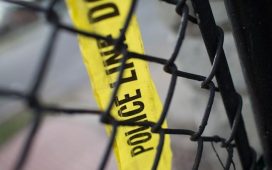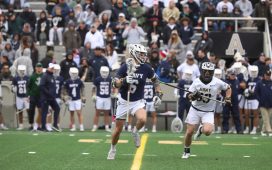Charlatan, with assistant trainer Jimmy Barnes (left), following his first-place finish in a division of the Arkansas Derby on May 2
Hall of Fame trainer Bob Baffert claims that two horses in his barn were “unknowingly and innocently exposed” to a banned substance that wound up in their post-race test samples from May 2 at Oaklawn Park in Hot Springs, Ark.
Information leaked from initial testing by the Arkansas Racing Commission’s contracted laboratory in late May indicated that Gamine and Charlatan both tested positive for the Class 2 drug lidocaine. Gamine won a May 2 allowance race by a neck. She subsequently won the Grade 1 Acorn Stakes at Belmont Park on June 20 by 18 ¾ lengths. Charlatan won a division of the Grade 1 Arkansas Derby and shortly thereafter suffered a minor ankle injury that will have him sidelined until after the Sept. 5 Kentucky Derby. Both horses are unbeaten in three starts.
Split samples, sent at Baffert’s request to the Equine Analytical Testing Laboratory at the University of California-Davis, confirmed the findings, as first reported in the New York Times.
Lidocaine is used by veterinarians during lameness examinations to “block” or numb a horse’s limbs. It is also commonly found in ointments and analgesic treatments and patches to alleviate pain in humans.
A statement from Baffert’s attorney, Craig Robertson, said both Gamine and Charlatan were exposed to the lidocaine from a patch worn by a member of the trainer’s staff suffering back pain while tending to the horses at Oaklawn.
“Even though lidocaine is a lawful, widely available therapeutic medication, it was never intentionally administered to either Gamine or Charlatan,” the statement reads. “When test results indicated that trace amounts of lidocaine were found in both horses after their respective races on May 2, Bob Baffert and his team were shocked. Leading up to May 2, both horses were healthy and worked hard to earn their victories that day.
“After investigation,” the statement continues, “it is our belief that both Gamine and Charlatanwere unknowingly and innocently exposed to lidocaine by one of Bob’s employees. The employee previously broke his pelvis and had been suffering from back pain over the two days leading up to May 2. As a result, he wore a Salonpas patch on his back that he personally applied. That brand of patch contains small amounts of lidocaine. It is believed that lidocaine from that patch was innocently transferred from the employee’s hands to the horses through the application of tongue ties by the employee that was handling both horses leading up to May 2.
“What I want to make clear are the following three points: 1) This is a case of innocent exposure and not intentional administration; 2) the levels of Lidocaine found in both Gamine and Charlatan that day were extremely small – 185 picograms for Gamine (in race 7), and 46 picograms for Charlatan (in race 11). A picogram is a trillionth of a gram. 3) It is our understanding that the trace amounts of Lidocaine found in both Gamine and Charlatan would not have had any effect on either horse – much less a performance enhancing one. The extreme sensitivity of modern-day testing can now pick up trace levels of innocent contaminants that have no effect on a horse. This is an issue that regulators of horse racing need to account for and address.
“Based on these facts, we intend on defending the cases involving Gamine and Chalatan before the Arkansas Racing Commission.”
Jimmy Barnes, assistant trainer for Baffert, saddled the horses at Oaklawn in the trainer’s absence. He suffered a fractured pelvis in September 2017.
Recommended penalty for a Class 2/Category B penalty drug like lidocaine is a minimum 15-day suspension and $500 fine for a first offense under Association of Racing Commissioners International Model Rules. A second offense has a 30-day penalty and $1,000 fine. Some racing commissions consider simultaneous violations of the same drug as a mitigating factor and do not increase penalties for a second offense.
The Model Rule also calls for disqualification, meaning the owners would lose the purse money from the races (Gamine earned $36,600 and Charlatan $300,000). In the case of Charlatan, the 100 qualifying points earned for the Kentucky Derby would be transferred to Basin, the second-place finisher (if the case is resolved before Sept. 5). Currently sidelined Gouverneur Morris finished third, Winning Impression fourth and Anneau d’Or fifth. Points for the Arkansas Derby division are awarded on the basis of 100-40-20-10 to the top four finishers.
Gamine is owned by Michael Lund Petersen. Charlatan is owned by the partnership of SF Racing LLC, Starlight Racing, Madaket Stables LLC, Stonestreet Stables LLC, Frederick Hertrich III, John D. Fielding and Golconda Stables.
An even bigger financial stake for the owners of Charlatan may be in the sale of breeding rights to Hill ‘n’ Dale Farm announced several days after the Arkansas Derby. Depending on the language and when the contract between the parties was signed, the sale price may have hinged on Charlatan being a Grade 1 winner. If the Speightstown colt is disqualified from the Arkansas Derby – his stakes debut – the sale price could be reduced by millions of dollars unless and until he officially becomes a Grade 1 winner in the future.
New to the Paulick Report? Click here to sign up for our daily email newsletter to keep up on this and other stories happening in the Thoroughbred industry.
Copyright © 2020 Paulick Report.






